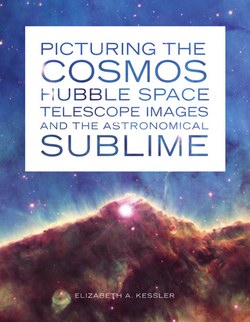Review: Picturing the Cosmosby Jeff Foust
|
| Many astronomers, she writes, look down on these publicly released images as little more than “pretty pictures” with no scientific importance. Yet, clearly, they have a strong impression on the public, and perhaps a deeper significance as well. |
But why is Hubble so beloved? Ideally it would be because it is such a productive scientific instrument, but that seems unlikely. How many people know that, to give one example, Hubble observations of supernovae provided some of the first evidence of dark energy and the accelerating expansion of the universe, leading to the 2011 Nobel Prize in Physics? Instead, perhaps, it’s because the telescope has provided stunning images of the solar system, galaxy, and beyond.
Art historian Elizabeth Kessler examines how these images are created, and their artistic and other significance, in her book Picturing the Cosmos. Many astronomers, she writes, look down on these publicly released images, such as those from the Hubble Heritage Project, as little more than “pretty pictures” with no scientific importance. Yet, clearly, they have a strong impression on the public, and perhaps a deeper significance as well.
Kessler examined how some of these Hubble images are created, a process that is both an art and a science. The raw images returned by Hubble are not visually appealing: grayscale images with cosmic rays and other artifacts. Astronomers, such as those working on the Hubble Heritage Project, go through a lengthy process to clean up the images and combine images taken at different wavelengths to create the stunning color images that are released, like the Horsehead Nebula images released by NASA last week to commemorate the telescope’s launch anniversary. But this scientific process is not without a human, artistic touch: one astronomer tells Kessler they tweak the colors they apply to the images so that things “look right” from their perspective. “And what exactly looks right is maybe a little hard to quantify,” he admits. In one case, he said, they applied some “wild colors” like pink and yellow to a nebula, only to go back to a more “classic” palette because it “somehow just didn’t feel right for us.”
Those aesthetic sensibilities, Kessler suggests, have parallels to the art of the American West of the 19th and early 20th centuries. Painters and photographers had to convey what were, to audience in the East, landscapes as alien as a nebula or galaxy. “Both sets of images propose that the natural world will overwhelm humanity by dwarfing us with its immensity,” she writes. Some astronomers working on the Hubble Heritage Project specifically cited artists like Ansel Adams and Albert Bierstadt as inspirations for their work.
“By evoking the Romantic sublime and the American frontier, they promise a universe of possibilities, a world of exploration, an experience of striving to comprehend,” Kessler says of Hubble images. “They remind us—as insignificant as we may be—of the potential to go beyond that which may at first seem to limit us.”
| The images from Hubble may be an essential, but perhaps alone not sufficient, explanation for the public’s support of this venerable space telescope. |
So, do such images explain the public’s love of Hubble? Kessler notes that there was a significant change in how the Space Telescope Science Institute presented images from Hubble starting in 1995, with the release of the so-called “Pillars of Creation” image of the Eagle Nebula, which had a strong, positive reaction from the public. Color images soon became the norm, which “signaled the greater attention paid to creating visually appealing images,” she writes.
Yet, Hubble doesn’t have a unique ability to make color images. And while its location above the atmosphere allows it to observe the universe in great detail, larger terrestrial telescopes equipped with adaptive optics that correct for the blurring of light as it passes through the atmosphere can do just a good as job, if not better, in many cases. However, the public doesn’t fawn over images from the Keck Observatory or the Very Large Telescope in the same way as it does Hubble. Cynics might argue, and underdstandably so, that Hubble has the support of a powerful NASA public relations machine that most terrestrial telescopes lack. Or, perhaps, the public has identified with and even anthropomorphized Hubble as it has with some other robotic spacecraft, particularly as it has survived near-death experiences and rallied to provide useful science—even if the public struggles to understand exactly what that science is. In this case, the images from Hubble are an essential, but perhaps alone not sufficient, explanation for the public’s support of this venerable space telescope.
